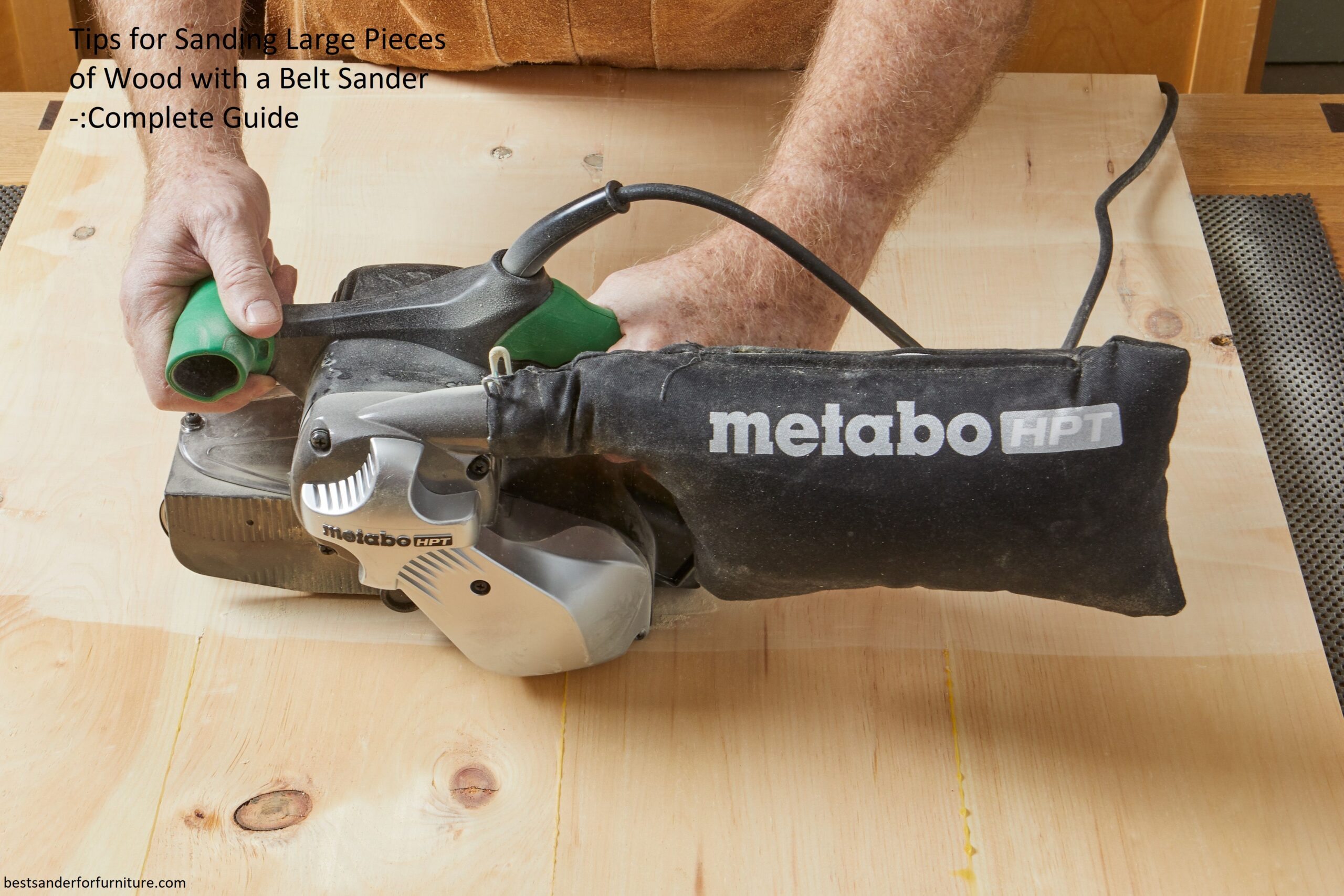Are you working with large pieces of wood and need to smooth it out with a belt sander? Do you want to know the tips and tricks for sanding large pieces of wood efficiently? You’re in the right place!
In this guide, I will provide all the information you need to make sanding easy and effortless.
Sanding is an important part of working with wood and can be used to create a smooth, polished surface. The most common tool used to sand large pieces of wood is the belt sander, which sandpaper is applied to a belt that moves rapidly in one direction.
When using a belt sander, it is important to keep safety in mind, as the workpiece can potentially cause damage if not handled properly. In this guide, we will offer tips for sanding wood using a belt sander so you can achieve your desired results quickly and safely.
Choosing the Right Belt Sander
When sanding large pieces of wood with a belt sander, it is important to choose the right tool for the job. Regarding belt sanders, size matters and it is usually better to opt for a larger sander than one of the smaller models. When selecting a belt sander, consider power level, weight and grip design.
Most workers prefer more powerful sanders rather than less powerful ones because they are able to remove material much faster. Power ratings range from 3 amps up to 5 amps and above, but it’s important to keep in mind that the higher the amp rating, the heavier the sander is likely to be. Heavier sanders can be difficult to maneuver over large surfaces or awkward angles and make it hard for workers to maintain control. However, some manufacturers offer additional features like vibration dampening or counter-balanced weights that help reduce fatigue from large jobs.
Workers should also consider how much weight they are willing to lug around when selecting a belt sander for larger surfaces; often times lighter models offer many of the same features as heavier ones at a slightly lower cost. Heavier duty sanders may also feature additional features such as anti-slip grips or padded handles which aid in maintaining control over large surfaces without tiring out your hands and arms too quickly. Additionally paying attention to grip design can help you find one best suited to your preferences designed by looking out for different details such as cushioning, molded panels or rubberized material designs.
Factors to consider when choosing a belt sander
Before choosing a belt sander, there are several factors to consider that will help to determine the right machine for the job. The size of the project and type of material will help determine which sander is best. Understanding these factors can help narrow down the options and enable you to choose the right tool for your project.
The most important factor when selecting a belt sander is its power. Belt sanders come in many different sizes, but it’s important to know how powerful each one is in order to determine which one will work best for your project. A more powerful sander can handle tougher materials such as hardwood and grainy surfaces, while a less powerful sander should be used on lighter materials such as softwood and plywood.
The size of the project can also influence which belt sander you should use. In general, larger projects require more powerful sanders that offer higher speed settings as well as broader belts that cover more surface area at once. Smaller projects may require something with lower speeds and narrower belts that allow greater control on smaller surfaces or closer detail work.
Finally, dust collection capabilities are an important feature to consider when selecting a belt sander. Many modern machines have dust collection systems that make sanding large pieces easier by keeping dust levels down during operation, prolonging machine life and helping maintain air quality in your workspace. Consider researching various models before deciding on a particular machine so you can make sure it meets your needs while staying within budget!
Recommended belt sanders for sanding large pieces of wood
When large pieces of wood need to be sanded, it’s best to use a belt sander. These powerful tools use abrasive-filled belts that rapidly abrade the material, resulting in quick, efficient and uniform results. The following list of belt Sanders is designed for those tackling large woodworking projects, capable of handling even large surfaces and edges with ease.
When buying a belt sander for working with wooden surfaces and edges, there are several features you should look for:
- High torque motor: Belt Sanders require a powerful motor to make sure the sanding belts last long and can tackle tougher materials;
- Dust collection: Dust collection is essential when sanding larger pieces of material as doing so can create a lot of mess. Look for models offering dust collection or vacuum port;
- Sandpaper speed control: Different materials at different speeds will yield different results; make sure you have speed adjustment options;
- Sandpaper compatibility: depending on the type and size of your project, you might need to use different types and sizes of paper. Choose a model that is readily compatible with these options;
- Ergonomic Grip/ Design: Many large projects involve lengthy operations – make sure your sander has ergonomically friendly design/grip so that it is easy on your hands.
Good examples include Skil Belt Sander 9x18V Brushless Cordless, BOSCH Professional GBS 75 AE Belt Sander, Einhell TE CB Watt Power X Change Plus Belt Sander TH PBS 760 I7658532 and Metabo SB 18 LT Compact Cordless 2 Speed Brushless Belt Sander.
Preparing the Work Area
Before setting up a work area for wood sanding, it’s important to make sure the area is clear of anything that may be knocked over or damaged by sawdust. Dust and sawdust will fly in the air when sanding, so any pieces of furniture near your work area should be covered with sheets or plastic in order to protect them. Additionally, it’s essential to use proper safety equipment such as a respirator that can attach to a dust collector, goggles, leather gloves and hearing protection.
The belt sander should be positioned in an area that gives easy access both sides as you will be working on both faces of the wood piece while sanding it. To ensure accuracy while moving the sander around during long strokes, make sure your body is directly behind the sander. Establish a working rhythm that enables you to hold small stamps with one hand and an even pressure for large areas with the other hand. Keep your arms slightly bent at all times for better control of the tool.
Since you won’t have full visibility on what is under the belt sander paper, start by lightly running on any crease or irregular areas then slowly apply increasing pressure with each pass until you are satisfied with results before changing belt direction or moving onto other sanding surfaces.
Clearing the work area
Before sanding with a belt sander, it’s important to take some time to properly clear the work area and set up the tool. To begin, make sure that the surface and surrounding area are free of any debris or dust that may interfere with your work. A clean workspace is always recommended in order to ensure a successful project.
Once you have cleared the area, it’s time to connect the belt sander. Make sure that you are working in a well-ventilated area and that you are wearing safety glasses and protective clothing. Plug the machine into an appropriate receptacle before beginning your project, as running power tools in damp environments can cause serious injury.
Finally, set up clamps along both sides of your work surface along either side of where you will be sanding. Clamps help hold the wood securely while preventing it from shifting during use. Once everything is prepared, take a few moments to review how best to approach your task by checking the manufacturer’s instructions or watching an online tutorial specific for belt sanders if needed. This can be invaluable in achieving a high-quality result with minimal effort and risk of injury, saving valuable time and resources in dismantling what could potentially become poor or damaged workmanship – so selecting right approach methodically can make all difference!
Choosing the right location
When sanding large pieces of wood, the machine used and the working environment are of the utmost importance. The belt sander is the ideal tool for this task, but if you work in a small enclosed space with poor airflow, you can experience breathing problems from inhaling too much dust. Therefore it is important to choose a location that offers sufficient ventilation during sanding operations.
In order to get best results and limit safety risks, select a spacious, well-ventilated area with adequate lighting and clear access to an electrical outlet. This will optimize efficiency and enable you to see clearly where your belt sander needs additional attention. Additionally, ensure your chosen area has plenty of room for controlling your equipment safely before beginning work.
Safety measures to take before starting the sanding process
Before you get started sanding any large pieces of wood, you should ensure that you have taken all necessary safety measures. This includes wearing safety glasses, a dust mask, and protective clothing such as heavy-duty Leather gloves when handling your belt sander.
Additionally, make sure to check the area around where you will be sanding for any small children or pets that might be in the vicinity and always ensure that you have total control of the power cord while operating the machine.
Make sure that there have been no modifications to your machine from its original design which would make it risky to use before beginning your sanding project.
Preparing the Wood for Sanding
Before you get started, you need to prep your wood for sanding. Depending on the type of wood you are working with, this might involve scraping off any existing finish with a paint scraper or removing glue and other debris with a putty knife. You should also take extra care to ensure the surface is free of any nails or screws.
Although most belt sanders come equipped with basic safety features such as dust collectors and guards, it is important to take precautions when sanding large pieces of wood. Start by wearing the proper protective gear such as goggles and dust masks to protect your eyes and lungs from wood particles that may be generated during operation. Additionally, it is recommended that long pants and closed-toe shoes are worn while working with a belt sander due to the potential hazard of fast-moving belts that could cause skin irritation or worse if accidentally exposed.
Lastly, make sure the surface is free of splinters and chunks before beginning with the belt sander. A quick pass over with a hand-held spindle sander may be necessary in order to smooth out bumps or crevices that can quickly wear down the belts on your belt sander if left untreated.
Inspecting the wood for imperfections
Before sanding a large piece of wood with a belt sander, it’s important to inspect the wood for any imperfections and remove them. Checking the surface of the wood for any splinters, rough edges, knots and cracks is important before you begin sanding. If necessary, you can use a wire brush or other tool to remove splinters and rough spots before using the sander.
High spots, such as raised grain caused by too much moisture in the wood should be sanded down with finer grits after using a belt sander.
Removing any unwanted material or coatings from the wood
When using a belt sander, it’s important to remember that power tools can cause serious injury. Safety should always be your top priority. Wear the appropriate personal protective equipment including eye protection, dust masks and gloves to ensure proper safety.
Before beginning the sanding process, verify if there are any unwanted materials on the wood. Common coatings include paint, varnish and other finishes. The best method for removing these is through chemical stripping as opposed to sanding, as this prevents damage to both yourself and the wood surface. Be sure to wear eye protection and protective clothing when making use of chemicals like paint strippers or removers.
Once all the existing coatings have been removed, you are ready to begin sanding with your belt sander. The first step is to use a coarse grit sandpaper (60-80 grit) before progressing through finer grits (100-120 grit). It’s important not to rush this step as it will give you control over what type of finish you achieve at the end of the project – varying grits will create different textures and finishes on wood surfaces. Start with a low speed setting when sanding woods with a belt sander and gradually increase speed when comfortable doing so without creating too much heat on top of the material or causing unnecessary marks or burns in soft woods like pine or cedar alternatives.
Once you have finished using each individual belt, be sure not to forget switching off both the machine itself and any machines related directly in order for these processes remain safe going forward.
Sanding down rough spots or edges
When sanding down rough spots or edges of large pieces of wood, it’s essential to use the right sanders and accessories. Begin by cutting out any nails, staples or screws with a sharp chisel, then use a belt sander to remove major protruding areas.
Safety is always paramount when working on a large piece of wood, so wear appropriate protective clothing such as safety eyewear and long leather gloves when using power tools. Adjust the tension on your belt sander as needed so that it runs red-hot but not smoldering. Move your sander from left to right in short bursts, stopping occasionally to make sure no snags exist on the wood surface. Be sure not to move too quickly; this will create uneven surfaces and scratches. Additionally, angle your sander slightly against the direction of the grain for smoother results.
A high-quality belt sander is key for a successful sanding job; you should investigate both its speeds (ranging anywhere between 600-2400 RPM) and sizes (from 1” – 4”). Using different grits also matters; start with rough grit such as 36 – 40 followed by 80 then 120 until you achieve velvety softness with 180–220 grit. Take frequent breaks while sanding so that heat isn’t generated inside the motor; this could damage your system and void its warranty. Have fun and enjoy the task!
Conclusion
Sanding large pieces of wood with a belt sander is an efficient way to get the desired look with minimal effort. Take time to understand the different types of sander belts and the various grits available so you can make an informed decision on what combination works best for your project.
Make sure to continuously move the sander back and forth, take breaks as needed, and clean off any dust particles prior to finishing. Doing all these steps will help you achieve beautiful, smooth sanded wood pieces that your audience will appreciate!
FAQ’S
How do you sand large amounts of wood?
To sand large amounts of wood, use a machine sander, such as a belt sander or a random orbital sander, and work in sections, using progressively finer grits of sandpaper.
How do you sand evenly with a belt sander?
To sand evenly with a belt sander, keep the sander moving, work in straight lines, and avoid tilting the sander to one side.
Why is my belt sander not sanding well?
Your belt sander may not be sanding well because the sandpaper may be worn, the tension may be incorrect, or the sander may need cleaning or maintenance.
What are the biggest sanding mistakes to avoid with a sanding machine?
The biggest sanding mistakes to avoid with a sanding machine include using the wrong grit sandpaper, applying too much pressure, and tilting the sander to one side.
How do you sand a large surface evenly?
To sand a large surface evenly, use a machine sander and work in sections, sanding in straight lines and overlapping each pass slightly.
Which sander would be most suitable for removing a large amount of wood?
A belt sander is most suitable for removing a large amount of wood, as it is designed to remove material quickly and efficiently.
What happens if you sand wood too much?
If you sand wood too much, you can damage the surface or alter the shape of the wood, leading to uneven finishes or gaps.
How do I know when I’ve sanded enough?
You know you’ve sanded enough when the surface is smooth and free of scratches or imperfections, and the wood feels even to the touch.
How do you sand a large piece of furniture?
To sand a large piece of furniture, use a machine sander and work in sections, being careful to sand evenly and not apply too much pressure.
What speed should you sand wood at?
The speed at which you should sand wood depends on the type of sander you are using and the task at hand. Check the manufacturer’s instructions or use a slower speed to avoid overheating and damaging the wood.
See more:
- Best cabinet sander 2023
- Best detail sander 2023
- Best disc sander 2023
- Best drum sander 2023
- Best drywall sander 2023


